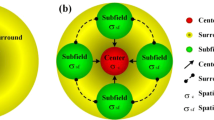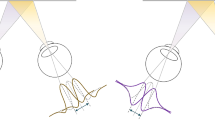Abstract
Extraction of object contours from the natural scene is a difficult task because it is hard to distinguish between object contour and texture edge. To overcome this problem, this paper presents a contour extraction method inspired by visual mechanism. Firstly, a biologically motivated surround inhibition process, improved by us, is applied to detect contour elements. Then we utilize visual cortical mechanisms of perceptual grouping to propose a contour grouping model. This model consists of two levels. At low level, a method is presented to compute local interaction between contour elements; at high level, a global energy function is suggested to perceive salient object contours. Finally, contours having high energy are retained while the others, such as texture edge, are removed. Experimental results show our method works well.
Access this chapter
Tax calculation will be finalised at checkout
Purchases are for personal use only
Preview
Unable to display preview. Download preview PDF.
Similar content being viewed by others
References
Marr, D., Hildreth, E.C.: Theory of edge detection. Proceedings of the Royal Society 207, 187–217 (1980)
Perona, P., Malik, J.: Scale-space and edge detection using anisotropic diffusion. PAMI 12(7), 629–639 (1990)
Canny, J.: A Computational Approach to Edge Detection. PAMI 8(6), 679–698 (1986)
Vinje, W.E., Gallant, J.L.: Natural Stimulation of the Nonclassical Receptive Field Increases Information Transmission Efficiency in V1. J. Neurosci. 22(7), 2904–2915 (2002)
Chen, G., Dan, Y., Li, C.Y.: Stimulation of non-classical receptive field enhances orientation selectivity in the cat. J. Physiol. 564(1), 233–243 (2005)
Grossberg, S., Mingolla, E., Ross, W.D.: Visual brain and visual perception: how does the cortex do perceptual grouping? Trends in neurosciences 20(3), 106–111 (1997)
Lee, T.S.: Computation in the early visual cortex. J. Physiol. 97(2), 121–139 (2003)
Walker, G., Ohzawa, I., Freeman, R.D.: Asymmetric Suppression Outside the Classical Receptive Field of the Visual Cortex. J. Neurosci. 19(23), 10536–10553 (1999)
Grigorescu, C., Petkov, N., Westenberg, M.A.: Contour and boundary detection improved by surround suppression of texture edges. Journal of Image and Vision Computing 22(8), 583–679 (2004)
Knierim, J.J., Van Essen, D.C.: Neuronal responses to static texture patterns in area V1 of the alert macaque monkey. J. Neurophysiol. 67(4), 843–856 (1995)
Papari, G., Campisi, P., Petkov, N.: A biologically motivated multiresolution approach to contour detection. Journal on Applied Signal Processing, 177–205 (2007)
Huang, T.S.: Two-Dimensional Signal Processing II: Transforms and Median Filters. Springer, Berlin (1981)
Saarinen, J., Levi, D.M., Shen, B.: Integration of local pattern elements into a global shape in human vision. PNAS 94, 8267–8271 (1997)
Von Der Heydt, R., Peterhans, E.: Mechanisms of contour perception in monkey visual cortex. I. Lines of pattern discontinuity. J. Neurosci. 9, 1731–1748 (1989)
Kanizsa, G.: Organization in Vision: Essays on Gestalt Perception. Praeger, New York (1979)
Field, D.J., Hayes, A., Hess, R.F.: Contour integration by the human visual system: evidence for a local ‘association field’. Vision Res. 33(2), 173–193 (1993)
Li, Z.: A neural model of contour integration in the primary visual cortex. Neural Comput. 10, 903–940 (1998)
Ursino, M., La Cara, G.E.: A model of contextual interaction and contour detection in primary visual cortex. Neural Networks 17, 719–735 (2004)
Kovace, I., Julesz, B.: Perceptual sensitivity maps within globally defined visual shapes 370, 644–646 (1994)
Author information
Authors and Affiliations
Editor information
Editors and Affiliations
Rights and permissions
Copyright information
© 2010 Springer-Verlag Berlin Heidelberg
About this paper
Cite this paper
Li, Y., Zhang, J., Jiang, P. (2010). Contour Extraction Based on Surround Inhibition and Contour Grouping. In: Zha, H., Taniguchi, Ri., Maybank, S. (eds) Computer Vision – ACCV 2009. ACCV 2009. Lecture Notes in Computer Science, vol 5995. Springer, Berlin, Heidelberg. https://doi.org/10.1007/978-3-642-12304-7_65
Download citation
DOI: https://doi.org/10.1007/978-3-642-12304-7_65
Publisher Name: Springer, Berlin, Heidelberg
Print ISBN: 978-3-642-12303-0
Online ISBN: 978-3-642-12304-7
eBook Packages: Computer ScienceComputer Science (R0)




